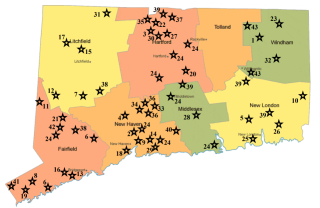Connecticut Native Perennial, Tree, & Shrub Availability List

This updated native tree and shrub availability list is designed to assist homeowners, landscapers, and conservation organizations in locating native planting stock for wildlife habitat enhancement. It was compiled from a survey of Connecticut’s registered nurseries. Of the respondents, many indicated that they have native trees, shrubs, or perennials in stock or would obtain them by special order. Although some of the listed nurseries are strictly wholesale businesses, trees and shrubs can often be ordered from them through your local retail nursery or garden center. Present this publication (PDF version here.pdf) to your local retailer and ask them to order plants for you if they do not already have them in stock.
Every plant is native to some location. When a plant is grown outside of its original location, it is usually classified as a non-native plant. Some non-native plants are invasive - they reproduce in great numbers, aggressively compete with native plants, and cause environmental harm. Invasive plants can severely impact the health of our ecosystems. For example, Norway maple (Acer platanoides), native to Europe and western Asia, is a non-native tree listed as invasive in the United States that has been widely planted as a street tree in our cities and suburbs. From suburban and rural areas, it has spread to adjacent woodlots, occupying space where native trees and shrubs may have otherwise grown. For more information about invasive plants, visit the Connecticut Invasive Plant Working Group website (cipwg.uconn.edu).
Planting a variety of plant species is an effective practice to deter possible disease and insect infestations. Native plants have adapted to the local climate, making them naturally hardy. Wildlife have evolved using them for food, cover and shelter. Proper selection, care, and placement of native plants can produce a landscape that is both visually attractive and beneficial to wildlife. Native plant descriptions, flowering and fruiting periods, site requirements, and wildlife habitat values may be found in the references at the end of this page.

